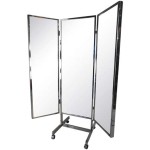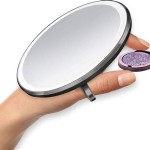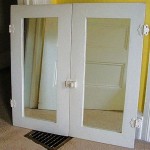How to Hang a Big, Frameless Mirror Securely
Frameless mirrors, with their sleek and minimalist aesthetic, can dramatically enhance the visual appeal of any living space. Their lack of a frame creates a sense of openess and seamlessly integrates the mirror with the surrounding decor. However, hanging a large, frameless mirror presents unique challenges compared to its framed counterparts. The weight and fragility of the glass require meticulous planning and execution to ensure secure and safe installation. This article provides a detailed guide on how to hang a large, frameless mirror, covering essential preparation, mounting options, and practical tips for a successful outcome.
Preparation is Paramount
Before attempting to hang a large frameless mirror, comprehensive preparation is essential. This encompasses accurate measurement, wall assessment, and gathering the necessary tools and materials. Rushing this stage can lead to errors, potential mirror damage, or an insecure mounting.
First, precisely measure the dimensions of the mirror, including its width, height, and thickness. These measurements will be crucial for determining the correct placement on the wall and selecting the appropriate mounting hardware. Double-check these measurements to avoid discrepancies during installation.
Next, carefully assess the wall where the mirror will be hung. Identify the wall construction material (drywall, plaster, concrete, etc.) as different materials require different types of anchors. Locate wall studs using a stud finder. Ideally, at least one mounting point should be anchored to a stud for maximum stability, especially for heavier mirrors. Mark the stud locations clearly with a pencil. If studs are not accessible at the desired mounting points, appropriate drywall anchors or concrete screws will be necessary.
Gather all the necessary tools and hardware before starting the installation. This includes:
- A level (preferably a long level for accurate alignment)
- A measuring tape
- A pencil
- A stud finder
- A drill with appropriate drill bits for the wall material
- Screwdrivers (Phillips head and flathead)
- Safety glasses
- Gloves
- Mirror mounting clips or a mirror adhesive
- Appropriate drywall anchors or concrete screws (if needed)
- Painter's tape (optional, for marking placement on the wall)
Consider having an assistant to help lift and position the mirror, particularly if it is large and heavy. Working alone can be risky and increase the chance of dropping or damaging the mirror.
Selecting the Right Mounting Method
Choosing the appropriate mounting method is critical to ensure the frameless mirror is securely attached to the wall and remains stable over time. The selection should be based on the mirror's weight, the wall's construction, and the desired aesthetic. Common mounting options include mirror clips, mirror adhesive, and Z-bar hangers.
Mirror Clips: Mirror clips are small metal or plastic brackets that hold the mirror's edges in place. They are available in various styles and sizes to accommodate different mirror thicknesses and weights. Clips are typically screwed into the wall and provide a secure and adjustable mounting solution. For large mirrors, use multiple clips along the top and bottom edges, and potentially the sides, to distribute the weight evenly. Ensure the clips are rated to support the mirror's weight. When installing, place the bottom clips first to provide a resting point for the mirror, then position the top and side clips to secure it in place.
Mirror Adhesive: Mirror adhesive is a specialized adhesive designed to bond mirrors to various surfaces. It provides a clean, frameless look without visible hardware. However, it is crucial to use a high-quality mirror adhesive that is specifically formulated for this purpose, as standard adhesives may damage the mirror's backing or fail to provide adequate support. Apply the adhesive in vertical beads across the back of the mirror, leaving some space between the beads for ventilation. Press the mirror firmly against the wall and support it with painter's tape or temporary props until the adhesive fully cures (usually 24-48 hours). Note that removing a mirror attached with adhesive can be challenging and may damage the wall.
Z-Bar Hangers: Z-bar hangers consist of two interlocking metal brackets, one attached to the back of the mirror and the other to the wall. The brackets interlock to create a secure and nearly invisible mounting system. Z-bar hangers are particularly suited for heavier mirrors, as they distribute the weight evenly across the wall. To install, attach one bracket to the back of the mirror using a strong adhesive or screws (depending on the bracket design). Ensure the bracket is level. Then, mount the corresponding bracket to the wall, aligning it with the bracket on the mirror. Finally, lift the mirror and slide the brackets together to lock it in place.
Consider the pros and cons of each method before making a decision. Mirror clips offer adjustability and relative ease of removal, while adhesive provides a clean, hardware-free look but is less forgiving. Z-bar hangers offer robust support for heavy mirrors but may require more precise installation.
Executing the Installation with Precision
Once the mounting method is selected and all preparatory steps are completed, the actual installation process can begin. Accuracy and attention to detail are crucial at this stage to ensure a secure and aesthetically pleasing result.
If using mirror clips, mark the locations for the clips on the wall, ensuring they are evenly spaced and aligned with the edges of the mirror. Use a level to ensure the bottom clips are perfectly horizontal, as these will support the weight of the mirror. Drill pilot holes at the marked locations, using the appropriate drill bit for the wall material. If drilling into drywall without a stud, insert drywall anchors into the pilot holes. Secure the bottom clips to the wall with screws, leaving a small gap between the clip and the wall to allow for the mirror's thickness. Carefully lift the mirror and rest it on the bottom clips. Position the top and side clips and secure them to the wall, ensuring the mirror is held firmly in place. Double-check the level of the mirror and make any necessary adjustments.
If using mirror adhesive, clean the back of the mirror and the wall surface with a clean cloth and isopropyl alcohol to remove any dust or grease. Apply the mirror adhesive to the back of the mirror in vertical beads, as described previously. Carefully lift the mirror and press it firmly against the wall, ensuring it is properly aligned. Use painter's tape to secure the mirror in place while the adhesive cures. Check the level of the mirror and make any necessary adjustments before the adhesive sets. Allow the adhesive to cure completely according to the manufacturer's instructions (usually 24-48 hours) before removing the tape.
If using Z-bar hangers, ensure the bracket on the back of the mirror is securely attached and properly aligned. Mark the location for the wall bracket on the wall, using the bracket on the back of the mirror as a guide. Use a level to ensure the wall bracket is perfectly horizontal. Drill pilot holes at the marked locations and insert drywall anchors or concrete screws as needed. Secure the wall bracket to the wall with screws. Carefully lift the mirror and slide the brackets together to lock it in place. Double-check the level of the mirror and make any necessary adjustments. Ensure the mirror is securely locked onto the wall bracket.
After the mirror is installed, inspect the mounting hardware to ensure it is properly secured and there are no signs of stress or strain. Clean the mirror surface with a glass cleaner to remove any fingerprints or smudges. Periodically check the mounting hardware to ensure it remains secure and the mirror is stable. If any issues are detected, address them promptly to prevent the mirror from falling.
Hanging a large frameless mirror requires careful planning, appropriate tools, and precise execution. By following these guidelines, one can successfully and safely install a frameless mirror, enhancing the aesthetic appeal and functionality of the living space.

How To Install A Mirror Without Frame Merrypad

How To Hang A Frameless Mirror On The Wall With Pictures

How To Install A Mirror Without Frame Merrypad

How To Hang A Frameless Mirror On The Wall With Pictures
:strip_icc()/DesireeBurnsInteriors1-f76d25cad90041c88fbae4a7dc10aab4.jpg?strip=all)
2 Simple Ways To Hang A Frameless Mirror

How To Hang A Frameless Mirror On The Wall With Pictures

How To Hang A Heavy Mirror Diy Family Handyman

How To Hang A Large Or Heavy Mirror

How To Hang A Heavy Mirror C R F T
How To Hang A 100 Pound Mirror On Drywall Quora








